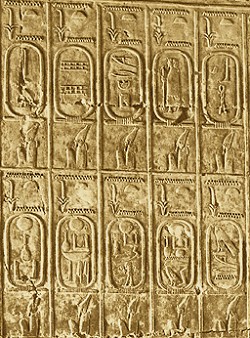
The founder of the dynasty was Psammetichus I, originally a member of the Libyan royal house in Saïs (which is why the period is also called the Saite Period). Psammetichus originally ruled in Egypt with the help of Assyria and ruled over Lower Egypt with other local princes (Herodotus speaks of twelve kings). With the help of Greek and Carian mercenaries he eventually succeeded in ruling alone. Upper Egypt also came under his control once he was able to repel the Kushites. Shortly after, he managed to free Egypt entirely by refusing to pay tribute to Assyria, now weakened by wars with other peoples. Later, he would even come to Assyria's assistance against Babylonia. Psammetichus's successor, Necho II, did the same, and on one campaign even reached the Euphrates. A short time later he was defeated by Nebuchadnezzar, a Babylonian ruler. Because of the growing power of Babylonia in western Asia, Egypt's power was limited to within its own borders. At this time, a colony of Jewish refugees settled in Elephantine, many details of which are known from Aramaic papyri found there. Under Psammetichus II, the last traces of Kushite influence were eradicated and the names of the kings removed from monuments in Upper Egypt. Psammetichus then conquered Nubia as far as the capital, Napata (4th Cataract). Apries, the son of Psammetichus, continued to fight against Babylonia, but could not prevent that country invading Jerusalem (586 BC) and banishing the inhabitants; some of them fled to Egypt. A short time later the Libyan ruler Adikran asked Apries for help against Greek colonists. The Egyptian army was subsequently defeated by the Greeks, the remains of the army mutinied under General Amasis, who forced Apries to acknowledge him as king. At the same time, the army of Nebuchadnezzar was approaching from the eastern Delta. Amasis probably had to agree to a treaty forcing him to abandon further expansion towards Asia. In 547 BC he even signed an alliance with Babylonia against the emerging Persian kingdom. In the years that followed, the Persians under King Cambyses advanced against Egypt and in 525 BC Memphis fell. The nationalism that had emerged during the 25th Dynasty, expressed in the art, among other things, was even more evident in the 26th Dynasty. Sculpture and painting were deliberately based on models from the Old and Middle Kingdoms. The models were copied as exactly as possible, as is demonstrated by a grid of lines drawn onto panels in the Step Pyramid of Djoser at Saqqara at this time, designed to help with copying the reliefs to the right scale. At the same time a new entrance way into the centre of the pyramid was constructed. Nevertheless, innovation also occurred, for example in religious practices.